
Rediscovering Japan

Rediscovering Japan
Travel (Nara Part 1 (Kofukuji/Todaiji))

by tomizuta
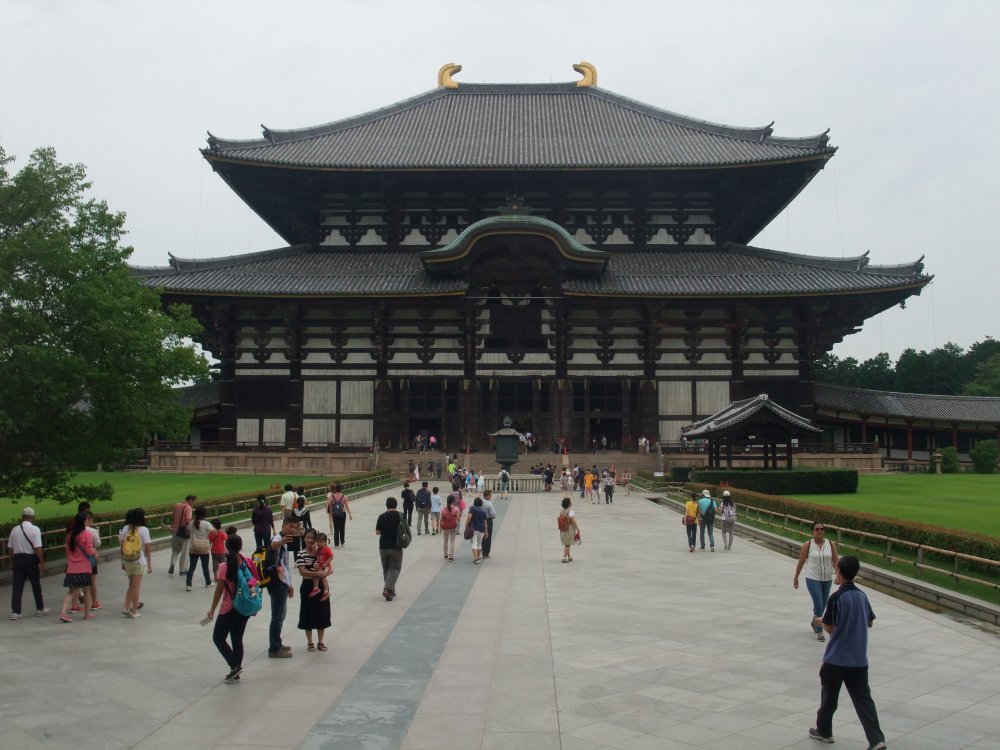
I thought the view from the admission area of the Great Buddha Hall of Todaiji resembled the view of Taj Mahal to some extent.
When we think about the ancient capitals of Japan, Kyoto immediately springs to mind. Indeed Kyoto was the capital of Japan from 794 A.D. to 1868 A.D., but the next is Nara which was the capital for close to a century from 710 A.D. I have been to Nara before, most recently in July 2016. On past occasions, we traveled on our own. But recently, I have come to think that the best way to explore these ancient cities is to ask a local guide to help us. So, in May 2024, I called a volunteer guide group in Nara, telling them that I was a guide myself, had been to Nara before, but wanted to take me along a route that they recommended for someone visiting Nara for the first time. I had booked a boutique hotel close to Kintetsu Nara Station where I arrived in the afternoon. Since I had time before meeting up with our guide on the following day, I decided to explore the area closest to Kintetsu Nara Station, Kofukuji Temple.
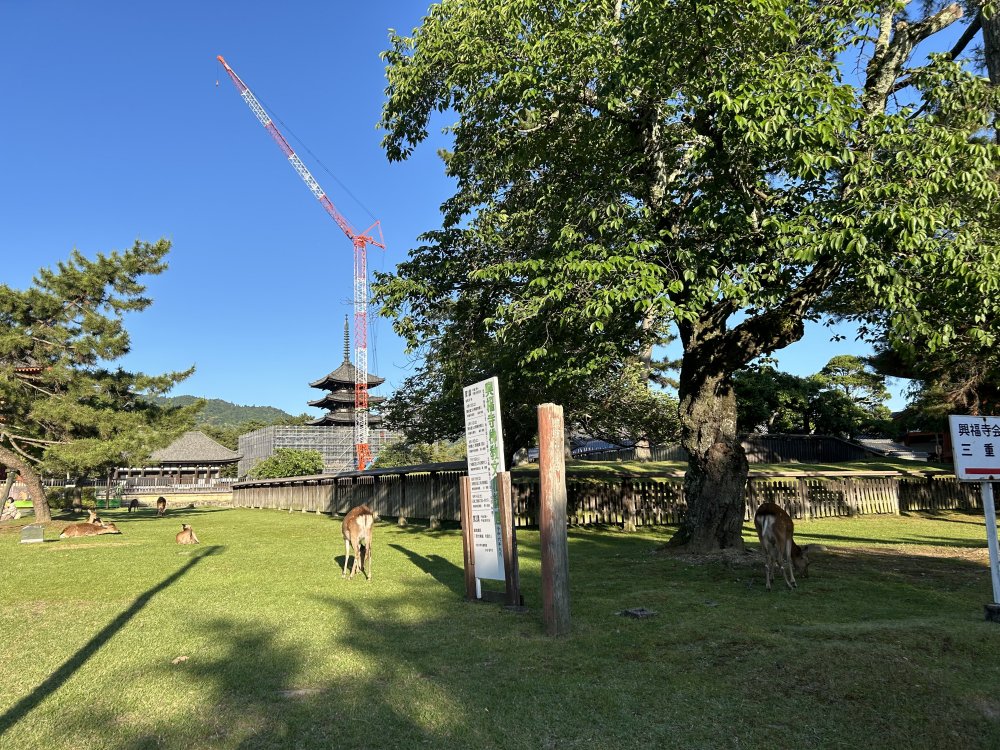
The pleasant view of the friendly deer and the five-story pagoda undergoing refurbishment in the far back in late afternoon at Kofukuji Temple.
As I learned later from the local guide, a vast area of current Nara was
part of Kofukuji Buddhist Temple. Kofukuji was the family temple of the
Fujiwara Family, the most powerful aristocratic clan during much of the
Nara and Heian Periods. It appears Kofukuji Temple was relocated from close
to Kashihara Jinguu Shinto Shrine to the south of Nara to the current location
when the capital was moved to Nara in 710 A.D. Following the recommendation
of the guidebook that I had purchased, I first visited the Hokuendo (translated
as the Northern Round Hall), designated as a national treasure. As noted
in the homepage of Kofukuji, “this building, whose round shape denotes
its status as a memorial chapel, was originally erected in 721 to mark
the one-year anniversary of the death of Kohfukuji’s founding patron, Fujiwara
no Fuhito (659–720).” The current building is a reconstructed building
dating back to 1189 after the entire temple complex was lost in fire caused
by an attack on the powerful temples including Kofukuji and Todaiji) in
Nara by the Taira clan (Heisi) in 1181.It seems that this hall is open
to the public only on limited occasions.
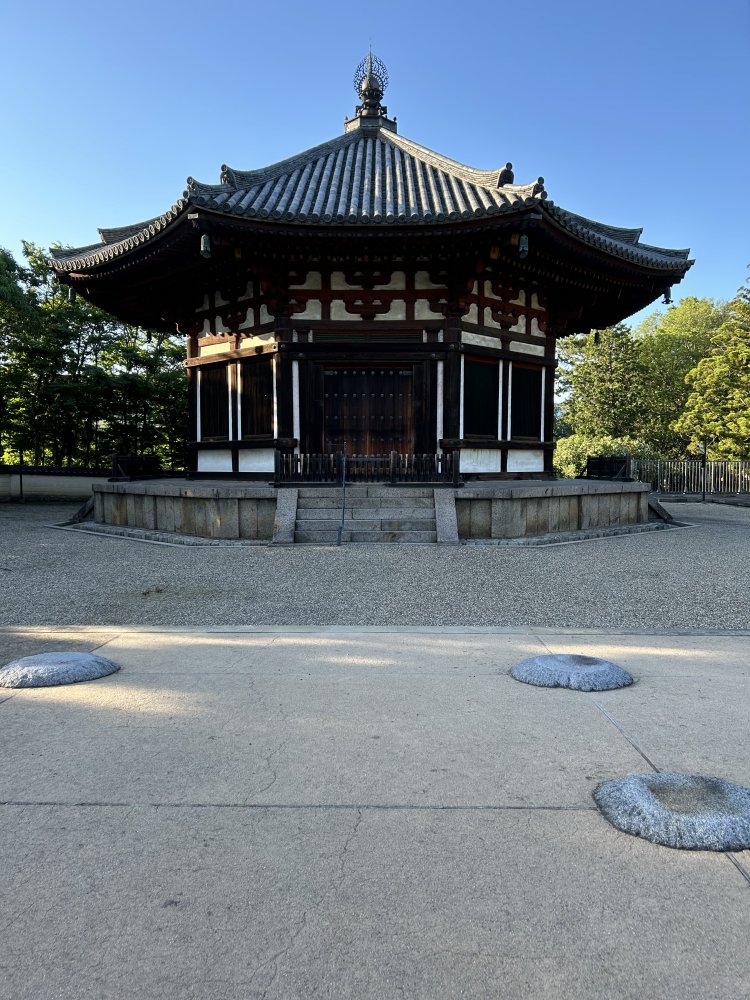
The Hokuendo was surrounded by a fence and was not directly accessible.
After taking a couple of photos from the outer fence protecting the Hokuendo I set out to visit Nan-endo (translated as the Southern Round Hall). One feature of Kofukuji is its five-storied pagoda, also designated as a national treasure. The current 51 meters tall pagoda was reconstructed in 1481. The pagoda was shrouded in scaffolding and cranes, indicating that it was undergoing a major renovation. Upon further investigation, I learned that a large-scale repair project, the first in 120 years, is underway and scheduled for completion in 2031. It seems I was fortunate to have been able to see even the upper part of the pagoda. Although past 5pm, there were still a lot of visitors to the Nan-endo. Details of the hall is as provided in the temple's website. Suffice it to say that it appeared as a most peaceful building housing many images that have been designated as a national treasure including the three-eyed, eight-armed image of Fukūkensaku Kannon (“the Kannon who bears the infallible snare”).

The pretty and peaceful Nan-endo.
My guidebook had told me that the five-story pagoda gracefully reflected in Sarusawa Pond was the very symbol of the ancient capital of Nara. I descended the stone steps from Nanden Hall and headed towards the pond. There were more overseas visitors than Japanese people sitting along the banks of the pond. Many of them were drinking the refreshments offered at Starbucks in front of the pond. As had been expected, the view of the five-story pagoda shrouded in scaffolding and cranes was not that appealing.

As had been expected, the view of the five-story pagoda shrouded in scaffolding and cranes was not that appealing.
The following morning, I met up with the local volunteer guide I had booked for five hours until 2pm including lunch. He first took us to the observatory on the rooftop of the main building of Nara Prefectural Office, which is open to the public. Access is easy to the rooftop using the lift from the ground floor. You can command a spectacular 360-degree view over Nara. From the observatory, our guide showed us where he had planned to take us. We would start from Todaiji Temple in the north east. First the Great Buddha Hall (Daibutsu-den) housing the 15-meter tall gigantic Rushanabutsu (Vairocana Buddha), followed by a walk to Nigatsu-do and Sangatsu-do. From there, we would trail the eastern mountain foothills to Kasuga Taisha Shrine, and in the afternoon, we would take the community bus to the Heijokyo Ruins in the west.
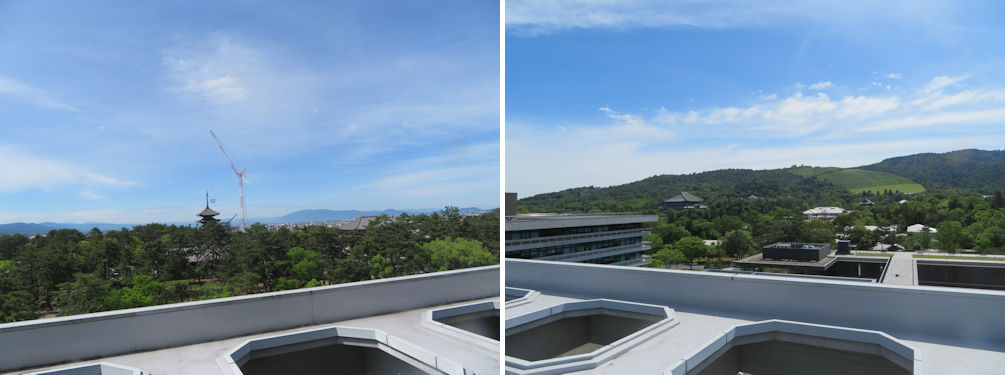
The panoramic view from the rooftop of Nara Prefectural Office. Looking south toward Kofukuji (left) and northeast to the Great Buddha Hall of Todaiji and the green plains of Wakakusayama (right).
As we walked to Todaiji Temple, the guide gave us a lot of interesting information. It is a known fact that the capital (or imperial residence) was moved to Kyoto in 794, partly because the court wished to distance itself from the powerful Buddhist sects of Nara. They were called Nanto Rikushuu (the six sects of Nara). Our guide told us that these sects practiced Buddhism for the nobles (contrary to the Buddhist sects from the Heian era onward that were teachings to commoners including the samurais), and that they were mainly educational organizations. This made sense to me, as Buddhism was imported to Japan in the 6th century, and there must have been a lot of need to study the religion. I was carrying a brown bag with my travel guidebook inside, which the friendly deer of Nara Park must have thought contained something to eat. There were quite a few visitors to Todaiji. Our guide jokingly said, “I guess we’re the only Japanese visitors, aside of the students on school tours and overseas visitors. We came to the entrance gate to Todaiji, the grand Nandaimon (Great South Gate). Here I was reminded by the guide that Todaiji, meaning the East Grand Temple, was called a grand temple because it was founded by an Emperor. Other temples cannot be called Grand Temple (Daiji). This reminded me of Saidaiji, which lies east of Heijo-kyo, the capital in the 8th century. Saidaiji did not fare as well as Todaiji, and is now a much smaller complex.
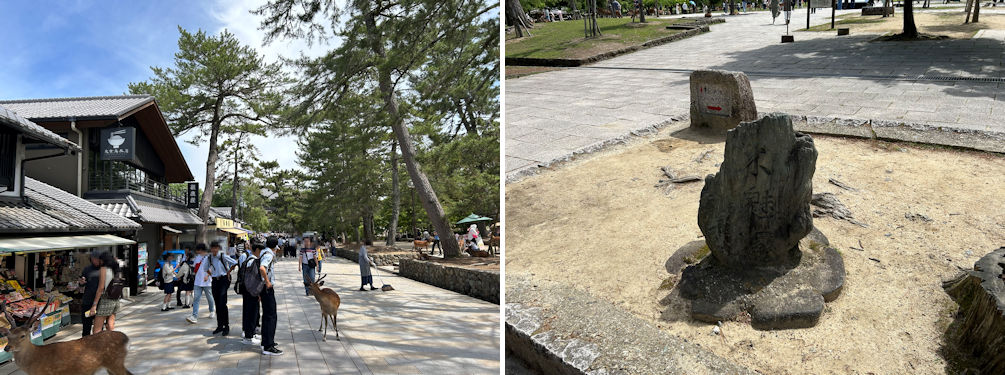
The scenery along the approach to the South Gate of Todai-ji Temple. A friendly deer mistook my brown bag for food and targeted it (left photo). Our guide drew my attention to a stone object located at the east corner of the entrance to the approach. This stone object, inscribed with "木魂塚" (Kodamazuka, meaning Echo Monument), is said to return an echo when one shouts towards Todai-ji Temple from it. The exact time of its creation is unknown (right photo).
Todaiji is packed with national treasures. The current Nandaimon Gate was
constructed in the early 13th century as part of the restoration work of
Todaiji, led by the high Buddhist priest Chogen, and is the largest temple
entrance gate in Japan. I took a moment to marvel at the dynamic 8 meters
high statues of Kongo Rikishi on both sides of the gate, one with the mouth
shut and one with the mouth open. The statues are masterpieces by the famous
sculptors Unkei and Kaikei.
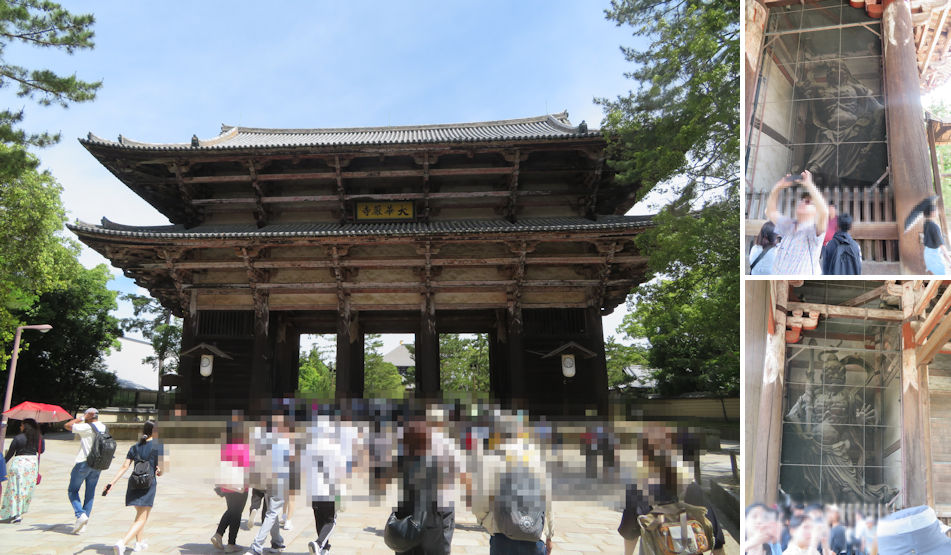
The grand Nandaimon (left) and the Kongo Rikishi statues (right).
We went through Nandaimon to proceed to the Chuumon (middle gate). But before we got to the Chuumon, our guide first led us into the facility on the left side. This was a facility called Kangakuin (literally, the institute for recommendation of study) where regular lecture courses are provided. “The temples of Nara were much more an academic organization than a purely religious one” he said. This made sense to me, as it was not hard to imagine the monks that had inherited Buddhism only two centuries ago would certainly have had a lot to study. On the other side of the approach to Chuumon is a pond called Kagamiike (mirror pond) so named because of the mirror-shaped island in the middle of the pond. The wataka (written in kanji characters as "horse fish") that inhabit Kagamiike are herbivorous fish and have been designated as a natural monument of Nara Prefecture.
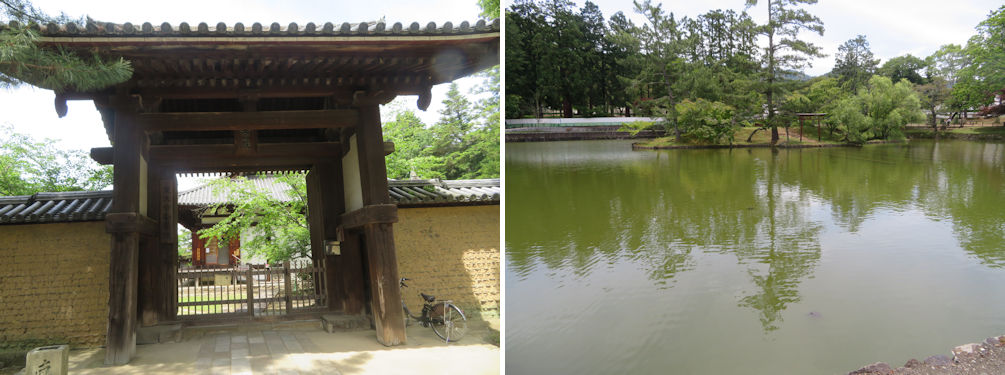 /p>
/p>
The Kangakuin (left) and Kagamiike (right).
Entry through the Chuumon is not allowed and visitors have to enter from
the entrance on the left corner which also served as the admission office
where we paid the entrance fee of 800 yen to enter the Great Buddha Hall.
Before this, our guide showed us something interesting which is not covered
in most guidebooks. The Chuumon Gate was constructed in 1617, so is of
a much later date than Nandaimon or the Great Buddha Hall. However, tucked
into both sides of the gate entrance are two statues of Buddhist figures,
Jikokuten and Bishamonten, placed there two years after the completion
of the Chuumon Gate.
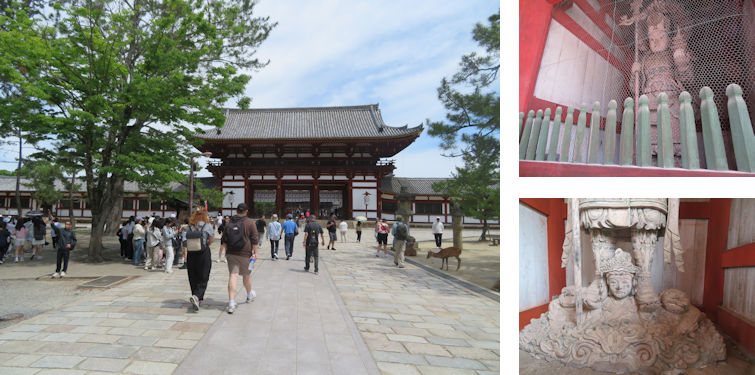
Approaching the Chuumon (left). The Bishamonten and the heavenly Goddess and the conquered evil spirit beneath (right).
Upon showing your ticket and entering the courtyard, the Great Buddha Hall
will come into view on the opposite side of the courtyard. I thought the
view from the admission area resembled the view of Taj Mahal to some extent.
Our guide drew our attention to a closed window above the entrance gate
to the hall. “That’s to show the giant Buddha’s face when it’s opened.”
I understand the window only opens a couple of days each year for rituals,
but was kept open during the closure of the temple due to the COVID-19
pandemic. In 743, Emperor Shōmu issued an edict to construct the Great
Buddha (Rushanabutsu), and the Great Buddha Hall (Daibutsuden) was completed
in 752. However, it was destroyed twice due to warfare, in 1180 and 1567.
The current Great Buddha Hall was rebuilt in 1707 during the Edo period
and has been designated a National Treasure. The official name of the Great
Buddha Hall is "Kondo," and it is the main temple building of
Todai-ji. It is one of the largest wooden structures in the world, measuring
57 meters wide, 50 meters deep, and 49 meters high.
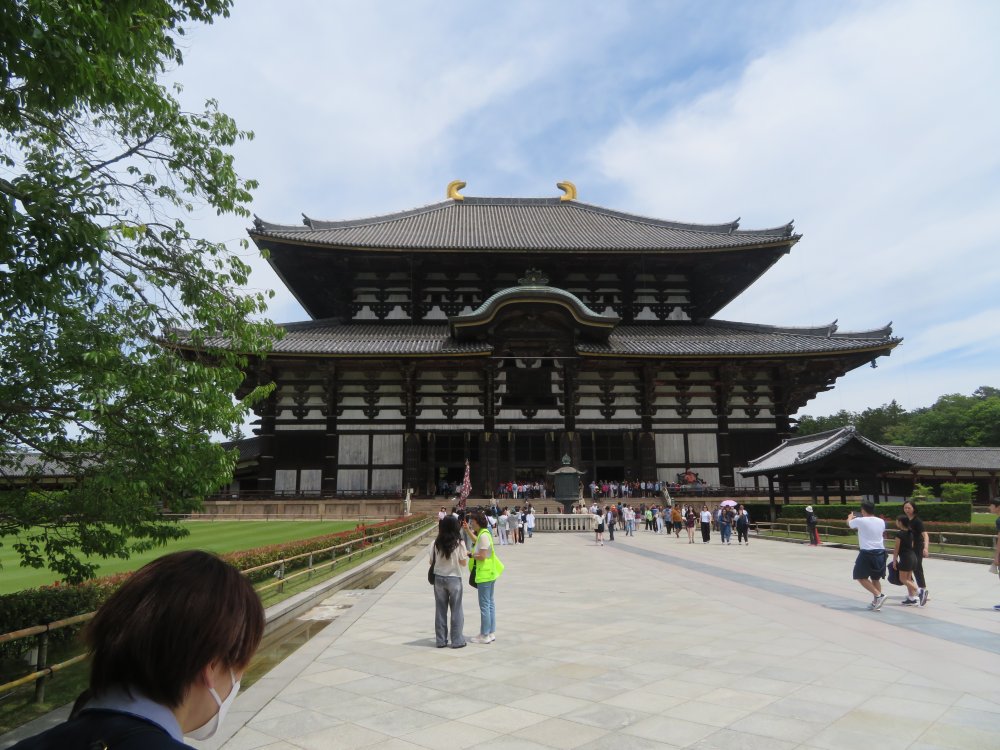
The official name of the Great Buddha Hall is "Kondo," and it is the main temple building of Todai-ji. It is one of the largest wooden structures in the world, measuring 57 meters wide, 50 meters deep, and 49 meters high.
Just in front of the Great Buddha Hall is an octagonal lantern with four
stationary panels ornamented with celestial musicians. This has stood here
since the founding of Todaiji. The 8th century lantern has also been designated
as a national treasure.
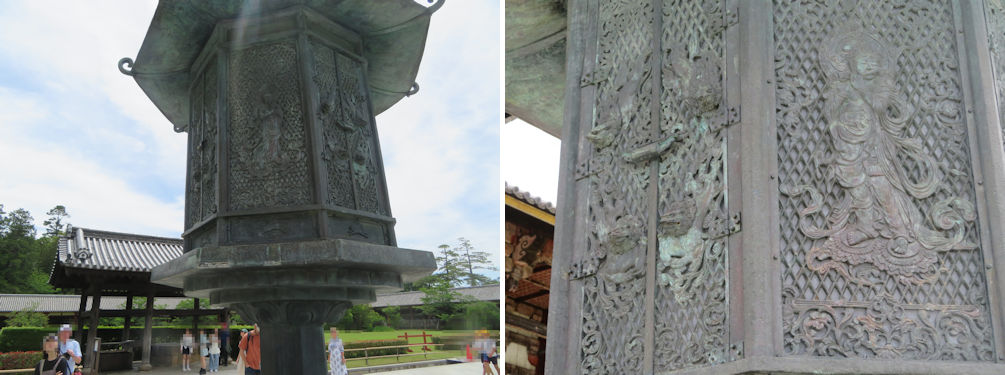
The octagonal lantern (left) and one of the celestial musicians (right).
We entered the hall to pay our respect to the giant Buddha, then went clockwise
to come back to the entrance. The seated statue of the Great Buddha is a 15-meter tall bronze statue. Due to repairs after damage from warfare and earthquakes during the Kamakura and Edo periods, the only parts that remain from the original construction are a few petals of the lotus pedestal and the knees. There are six statues other than the Giant
Buddha. Flanking the Great Buddha on either side are two attendant bodhisattvas:
Kokuzo Bosatsu to the Buddha's right (visitor's left) and Nyoirin Kannon
to the Buddha's left. Although dwarfed by the size of the giant Buddha
the statues are about seven meters tall. They date back to the 18th century
and have been designated as important cultural property. Surrounding the
Great Buddha are standing statues of two of the four heavenly kings, Kōmokuten
and Tamonten.
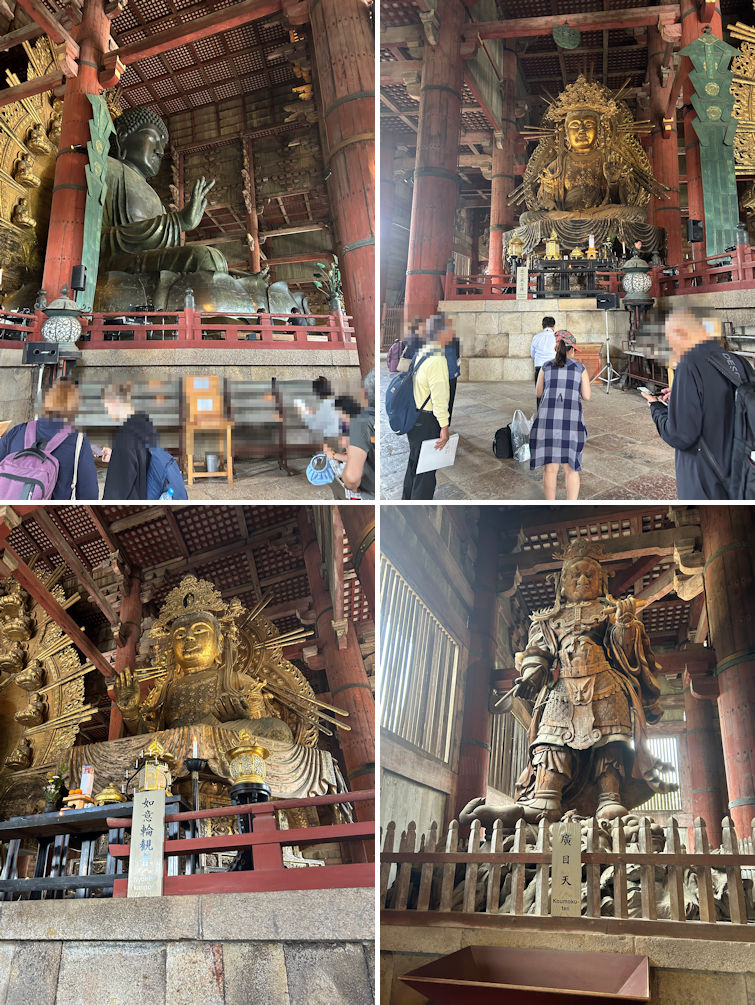
The seated Giant Buddha (upper left), attendant bodhisattvas Kokuzo Bosatsu (upper right), Nyoirin Kannon (lower left), and one of the four heavenly kings Komokuten (lower right).
Inside the hall, to the back of the giant Buddha, there are miniature replicas
of the original Buddha Hall and the current hall to show how the current
hall was downsized from eleven bays to seven bays. Before leaving the hall,
our guide showed us a wooden statue of Binzuru from the late Edo era sitting
to the right of the hall entrance. It is believed if you rub a part of
Binzuru and then your same part, your illness will be cured.

Before leaving the hall, our guide showed us a wooden statue of Binzuru from the late Edo era sitting to the right of the hall entrance.